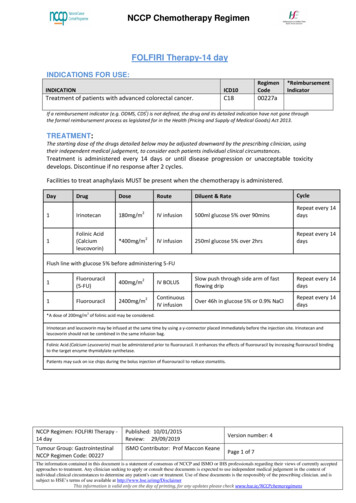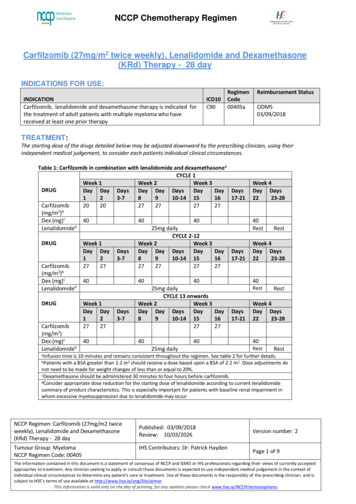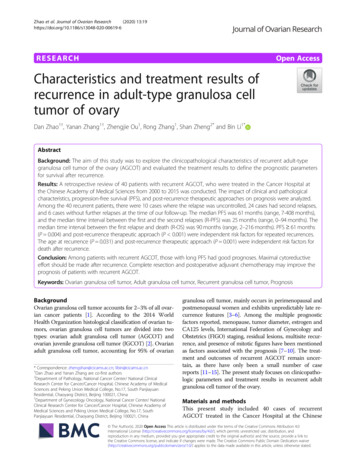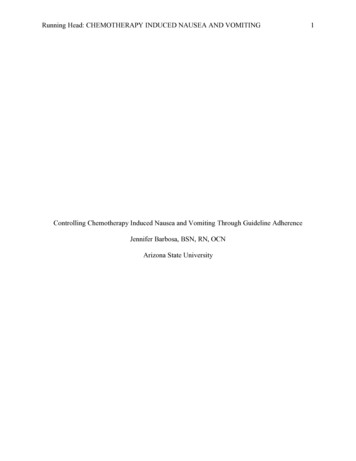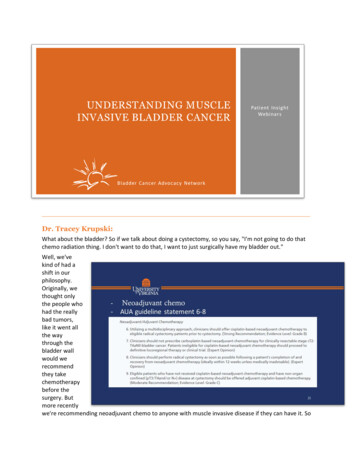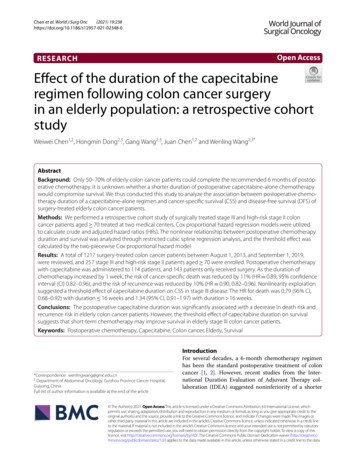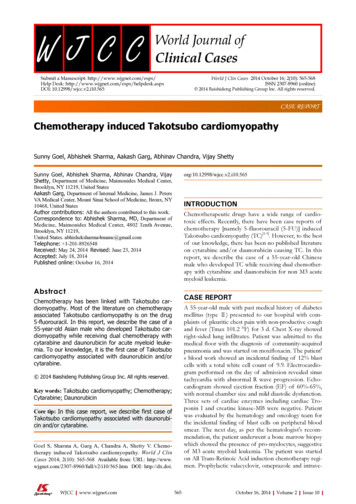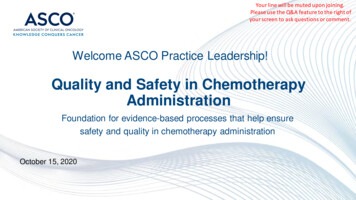
Transcription
NCCP Chemotherapy RegimenFOLFIRINOX TherapyINDICATIONS FOR etastatic pancreatic cancer.C2500329aHospitalTREATMENT:The starting dose of the drugs detailed below may be adjusted downward by the prescribing clinician, usingtheir independent medical judgement, to consider each patients individual clinical circumstances.Treatment is administered every 14 days or until disease progression or unacceptable toxicitydevelops to a maximum of 12 cycles.Facilities to treat anaphylaxis MUST be present when the chemotherapy is administered.DayDrugDoseRouteDiluent & RateCycle1Oxaliplatin85 mg/m2IV500mls 5% glucose over 2 hoursimmediately followed by:Repeat every 14days1Folinic Acid(Calciumleucovorin)aIV infusion250ml 0.9% NaCl over 2 hours with theaddition after 30 minutes of irinotecanas belowRepeat every 14days1Irinotecan180mg/m2IV infusion250ml 0.9% NaCl over 90mins giventhrough a Y connector placedimmediately before the injection siteImmediately followed byRepeat every 14days15-Fluorouracil400mg/m2IV BOLUSSlow push through side arm of fastflowing dripRepeat every 14days15-Fluorouracilb2400mg/m2ContinuousIV infusionOver 46 hours in 0.9% NaClRepeat every 14daysaA400mg/m2dose of 200mg/m2 of folinic acid may be considered.Oxaliplatin is not compatible with normal saline. Do not piggyback or flush lines with normal saline.For oxaliplatin doses 104mg use 250ml glucose 5%.Increase infusion rate time to 4 – 6 hours in case of laryngopharyngeal dysaesthesia reactionOxaliplatin administration must always precede the administration of 5-FU.Folinic Acid (Calcium Leucovorin) must be administered prior to fluorouracil. It enhances the effects of fluorouracil by increasing fluorouracil bindingto the target enzyme thymidylate synthetase.bSee dose modifications section for patients with identified partial DPD deficiencyAcute neurotoxicity is common with oxaliplatin and can be precipitated on exposure to the cold therefore in this regimen patients should NOT suckon ice chips during the bolus injection of fluorouracil.NCCP Regimen: FOLFIRINOXTherapyPublished: 03/06/2016Review: 27/05/2025Tumour Group: GastrointestinalNCCP Regimen Code: 00329ISMO Contributor: Prof Maccon KeaneVersion number: 5Page 1 of 10The information contained in this document is a statement of consensus of NCCP and ISMO or IHS professionals regarding their views of currentlyaccepted approaches to treatment. Any clinician seeking to apply or consult these documents is expected to use independent medical judgement in thecontext of individual clinical circumstances to determine any patient's care or treatment. Use of these documents is the responsibility of the prescribingclinician and is subject to HSE’s terms of use available at http://www.hse.ie/eng/DisclaimerThis information is valid only on the day of printing, for any updates please check www.hse.ie/NCCPchemoregimens
NCCP Chemotherapy RegimenELIGIBILITY: Indications as aboveECOG 0-1Adequate haematological, renal and liver status.CAUTION:Use with caution in patients with: Previous pelvic radiotherapy Recent MI Uncontrolled angina, hypertension, cardiac arrhythmias, CHF In patients with baseline greater than 3 loose bowel movements (BM) per day (inpatients without colostomy or ileostomy) Symptomatic peripheral neuropathyEXCLUSIONS: Hypersensitivity to irinotecan, oxaliplatin, 5-fluorouracil or any of the excipientsBaseline neutrophils 2 x 109/L and/or platelet count 100 x 109/LSevere renal impairment (creatinine clearance 30ml/min)Bilirubin 3 x ULNChronic bowel disease and/or bowel obstructionPregnancy and lactationSevere bone marrow failureCNS metastasesKnown complete DPD deficiencyPRESCRIPTIVE AUTHORITY:The treatment plan must be initiated by a Consultant Medical Oncologist.TESTS:Baseline tests: Blood, liver and renal profile ECG (if patient has compromised cardiac function) DPD testing prior to first treatment with 5-Fluorouracil using phenotype and/orgenotype testing unless patient has been previously testedRegular tests: Blood, liver and renal profile prior to each cycle Evaluate for peripheral neuropathy every cycle prior to proceeding with treatmentDisease monitoring:Disease monitoring should be in line with the patient’s treatment plan and any other test/sas directed by the supervising Consultant.NCCP Regimen: FOLFIRINOXTherapyPublished: 03/06/2016Review: 27/05/2025Tumour Group: GastrointestinalNCCP Regimen Code: 00329ISMO Contributor: Prof Maccon KeaneVersion number: 5Page 2 of 10The information contained in this document is a statement of consensus of NCCP and ISMO or IHS professionals regarding their views of currentlyaccepted approaches to treatment. Any clinician seeking to apply or consult these documents is expected to use independent medical judgement in thecontext of individual clinical circumstances to determine any patient's care or treatment. Use of these documents is the responsibility of the prescribingclinician and is subject to HSE’s terms of use available at http://www.hse.ie/eng/DisclaimerThis information is valid only on the day of printing, for any updates please check www.hse.ie/NCCPchemoregimens
NCCP Chemotherapy RegimenDOSE MODIFICATIONS: Consider a reduced starting dose in patients with identified partial DPD deficiency.o Initial dose reduction may impact the efficacy of treatment. In the absenceof serious toxicity, subsequent doses may be increased with carefulmonitoring.Any dose modification should be discussed with a ConsultantThe following dose reductions should be used when calculating FOLFIRINOX dosereductions for patients with toxicitiesTable 1: Dose Reduction Levels for All ToxicitiesDose Level 0OxaliplatinIrinotecanFluorouracil bolusFluorouracil infusion285 mg/m180 mg/m2400 mg/m22400 mg/m2Dose Level -1265 mg/m150 mg/m2320 mg/m22000 mg/m2Dose Level -2*50 mg/m2120 mg/m2200 mg/m21600mg/m2Folinic acid is delayed or omitted if bolus fluorouracil is delayed or omitted*For any additional dose reductions, use 20% less than previous level or consider discontinuing this regimen.Haematological Treatment is not administered unless ANC 1.5 x 109L and platelets 75 x 109/L. If levels are below this at Day 1 treatment may be delayed for 1-2 weeks. If no recovery in 2 weeks consideration should be given to discontinuing thetreatment.Table 2: Dose modification of FOLFIRINOX based on Day 1 Absolute Neutrophil Count (ANC)IrinotecanOxaliplatin5-Fluorouracilst1 occurrence of ANC 1.5 xReduce dose toMaintain full doseOmit bolus109/L150mg/m25-Fluorouracil*2nd occurrence ofMaintainReduce to 60mg/m2ANC 1.5 x 109/L150mg/m2 doserd3 occurrence ANC 1.5 xSTOP TREATMENT109/LTable 3: Dose modification of FOLFIRINOX based on Day 1 Platelet CountIrinotecanOxaliplatin1st occurrence ofMaintain full doseReduce to 60mg/m29platelets 75 x10 /L2nd occurrence ofReduce dose toMaintain at 60mg/m292platelets 75 x10 /L150mg/m3rd occurrence ofSTOP TREATMENTplatelets 75 x109/LNCCP Regimen: FOLFIRINOXTherapyPublished: 03/06/2016Review: 27/05/2025Tumour Group: GastrointestinalNCCP Regimen Code: 00329ISMO Contributor: Prof Maccon Keane5-FluorouracilReduce both the bolusand infusion to 75% ofthe original doseVersion number: 5Page 3 of 10The information contained in this document is a statement of consensus of NCCP and ISMO or IHS professionals regarding their views of currentlyaccepted approaches to treatment. Any clinician seeking to apply or consult these documents is expected to use independent medical judgement in thecontext of individual clinical circumstances to determine any patient's care or treatment. Use of these documents is the responsibility of the prescribingclinician and is subject to HSE’s terms of use available at http://www.hse.ie/eng/DisclaimerThis information is valid only on the day of printing, for any updates please check www.hse.ie/NCCPchemoregimens
NCCP Chemotherapy RegimenTable 4: Dose modification of FOLFIRINOX based on low nadir blood counts or in case of infectionIrinotecanOxaliplatin5-Fluorouracil1st occurrence ofReduce dose toMaintain full doseOmit bolus150mg/m25-Fluorouracil Febrileneutropenia ANC 0.5 x 109Lfor 7 days Infection withconcomitant ANC 1 x 109/Lnd2 occurrence ofMaintain 150mg/m2Reduce to 60mg/m2dose Febrileneutropenia ANC 0.5 x 109Lfor 7 days Infection withconcomitant ANC 1 x 109/Lrd3 occurrenceSTOP TREATMENT Febrileneutropenia ANC 0.5 x 109Lfor 7 days Infection withconcomitant ANC 1 x 109/Lst1 occurrence ofMaintain full doseReduce to 60mg/m2Reduce both the bolus9Platelets 50x 10 /Land infusion to 75% ofthe original dose2nd occurrence ofReduce dose toMaintain at 60mg/m2Reduce infusionalPlatelets 50x 109/L150mg/m2dose by an additional25%rd3 occurrence ofDiscontinue treatmentPlatelets 50x 109/L*For any febrile neutropenia or a 2nd episode of ANC 1x109/L. G-SCF prophylaxis should beconsidered for subsequent cycles.NCCP Regimen: FOLFIRINOXTherapyPublished: 03/06/2016Review: 27/05/2025Tumour Group: GastrointestinalNCCP Regimen Code: 00329ISMO Contributor: Prof Maccon KeaneVersion number: 5Page 4 of 10The information contained in this document is a statement of consensus of NCCP and ISMO or IHS professionals regarding their views of currentlyaccepted approaches to treatment. Any clinician seeking to apply or consult these documents is expected to use independent medical judgement in thecontext of individual clinical circumstances to determine any patient's care or treatment. Use of these documents is the responsibility of the prescribingclinician and is subject to HSE’s terms of use available at http://www.hse.ie/eng/DisclaimerThis information is valid only on the day of printing, for any updates please check www.hse.ie/NCCPchemoregimens
NCCP Chemotherapy RegimenRenal and Hepatic Impairment:Table 5: Recommended dose modifications for patients with renal or hepatic impairmentDrugRenal impairmentHepatic impairmentOxaliplatinCrCl (ml/min)DoseLittle information available.Probably no dose reduction necessary. 30Treat at normaldose and monitorrenal functionClinical decision. 30ContraindicatedIrinotecanNo dose reduction needed, howeverIrinotecan is contraindicated in patients with bilirubinuse with caution as no information inlevels 3 x ULN.this setting.5-FluorouracilConsider dose reduction in severerenal impairment onlyBilirubin(micromol/L)ASTDose 85 180100% 85or 180ContraindicatedClinical decision.Moderate hepatic impairment; reduce initial dose by 1/3.Severe hepatic impairment, reduce initial dose by 1/2.Increase dose if no toxicityManagement of adverse events:Table 6: Dose Modifications for Oxaliplatin NEUROLOGIC ToxicityToxicity GradeDuration of Toxicity1-7 days 7 days1Maintain dose levelMaintain dose level2Maintain dose levelMaintain dose level 3 1 dose level 1 dose level1st occurrence 1 dose level 1 dose level2nd occurrence4Discontinue therapy Discontinue therapyLaryngo-pharyngealMaintain dose levelIncrease infusion time fromdysaesthesia2 to 6 hrsNCCP Regimen: FOLFIRINOXTherapyPublished: 03/06/2016Review: 27/05/2025Tumour Group: GastrointestinalNCCP Regimen Code: 00329ISMO Contributor: Prof Maccon KeanePersistent (present at startof next cycle)Maintain dose level 1 dose levelDiscontinue therapyDiscontinue therapyIncrease infusion time from2 to 6 hrsVersion number: 5Page 5 of 10The information contained in this document is a statement of consensus of NCCP and ISMO or IHS professionals regarding their views of currentlyaccepted approaches to treatment. Any clinician seeking to apply or consult these documents is expected to use independent medical judgement in thecontext of individual clinical circumstances to determine any patient's care or treatment. Use of these documents is the responsibility of the prescribingclinician and is subject to HSE’s terms of use available at http://www.hse.ie/eng/DisclaimerThis information is valid only on the day of printing, for any updates please check www.hse.ie/NCCPchemoregimens
NCCP Chemotherapy RegimenTable 7: Dose modification schedule based on non-haematological, non-neurological toxicitiesPrior to a Cycle (DAY 1)Grade ofDose Level for Subsequent ntain dose level1 and 2 Grade 2, hold treatment max of 2weeks Grade 2 within 2 weeks proceed with 1 dose level of irinotecan and infusional 5-Fluorouracil.3treatment at the dose level notedDiscontinue bolus 5-Fluorouracil and leucovorinacross from the highest gradeexperienced 1 dose levels of oxaliplatin and infusional 5-Fluorouracil. Remains Grade 2 after 2 weeks,4Discontinue irinotecan, bolus 5-Fluorouracil and leucovorindiscontinue treatmentStomatitis Grade 2, hold treatment max of 2weeks Grade 2 within 2 weeks proceed withtreatment at the dose level notedacross from the highest gradeexperienced. Remains Grade 2 after 2 weeks,discontinue treatment1 and 2Maintain dose level3 1 dose level of bolus and infusional 5-F Fluorouracil4 1 dose level of oxaliplatin, irinotecan and infusionalfluorouracil.Discontinue bolus 5- Fluorouracil and leucovorinSUPPORTIVE CARE:EMETOGENIC POTENTIAL: High (Refer to local policy).PREMEDICATIONS:Prophylactic atropine sulphate 250micrograms subcutaneously – see adverse effects below.Atropine should not be used in patients with glaucoma. (See Adverse Effects/Regimen specificcomplications below).OTHER SUPPORTIVE CARE:Anti-diarrhoeal treatment (Refer to local policy).Patients should be made aware of the risk of delayed diarrhoea occurring more than 24 hours afterthe administration of irinotecan and at any time before the next cycle. As soon as the first liquid stool occurs, the patient should start drinking large volumes ofbeverages containing electrolytes and an appropriate anti-diarrhoeal therapy must be initiatedimmediately. The currently recommended anti-diarrhoeal treatment consists of high doses of loperamide (4mg for the first intake and then 2 mg every 2 hours). This therapy should continue for 12 hours after the last liquid stool and should not bemodified. In no instance should loperamide be administered for more than 48 consecutive hours atthese doses, because of the risk of paralytic ileus, nor for less than 12 hours.Patients should be warned about the potential for dizziness or visual disturbances which may occurwithin 24 hours following the administration of irinotecan, and advised not to drive or operatemachinery if these symptoms occur.NCCP Regimen: FOLFIRINOXTherapyPublished: 03/06/2016Review: 27/05/2025Tumour Group: GastrointestinalNCCP Regimen Code: 00329ISMO Contributor: Prof Maccon KeaneVersion number: 5Page 6 of 10The information contained in this document is a statement of consensus of NCCP and ISMO or IHS professionals regarding their views of currentlyaccepted approaches to treatment. Any clinician seeking to apply or consult these documents is expected to use independent medical judgement in thecontext of individual clinical circumstances to determine any patient's care or treatment. Use of these documents is the responsibility of the prescribingclinician and is subject to HSE’s terms of use available at http://www.hse.ie/eng/DisclaimerThis information is valid only on the day of printing, for any updates please check www.hse.ie/NCCPchemoregimens
NCCP Chemotherapy RegimenADVERSE EFFECTS / REGIMEN SPECIFIC COMPLICATIONSThe adverse effects listed are not exhaustive. Please refer to the relevant Summary of Product Characteristics forfull details. Neutropenia: Fever or other evidence of infection must be assessed promptly and treatedappropriately.Oxaliplatin Platinum Hypersensitivity: Special surveillance should be ensured for patients with a historyof allergic manifestations to other products containing platinum. In case of anaphylacticmanifestations the infusion should be interrupted immediately and an appropriatesymptomatic treatment started. Re-administration of oxaliplatin to such patients iscontraindicated. Laryngopharyngeal dysaesthesia: An acute syndrome of laryngopharyngeal dysaesthesiaoccurs in 1% - 2% of patients and is characterised by subjective sensations of dysphagia ordyspnoea/feeling of suffocation, without any objective evidence of respiratory distress (nocyanosis or hypoxia) or of laryngospasm or bronchospasm. Symptoms are often precipitatedby exposure to cold. Although antihistamines and bronchodilators have been administered insuch cases, the symptoms are rapidly reversible even in the absence of treatment.Prolongation of the infusion helps to reduce the incidence of this syndrome. Gastrointestinal toxicity: It manifests as nausea and vomiting and warrants prophylacticand/or therapeutic anti-emetic therapy. Dehydration, paralytic ileus, intestinal obstruction,hypokalemia, metabolic acidosis and renal impairment may be caused by severediarrhoea/emesis particularly when combining oxaliplatin with 5FU. Extravasation: Oxaliplatin causes irritation if extravasated (Refer to local policy). Venous occlusive disease: A rare but serious complications that has been reported in patients(0.02%) receiving oxaliplatin in combination with fluorouracil. This condition can lead tohepatomegaly, splenomegaly, portal hypertension and/or esophageal varices. Patients shouldbe instructed to report any jaundice, ascites or hematemesis immediately. Haemolytic Ureamic Syndrome (HUS): Oxaliplatin therapy should be interrupted if HUS issuspected: hematocrit is less than 25%, platelets less than 100,000 and creatinine greater thanor equal to 135 micromol/L. If HUS is confirmed, oxaliplatin should be permanentlydiscontinued.Irinotecan Acute cholinergic syndrome: If acute cholinergic syndrome appears (defined as early diarrhoeaand various other symptoms such as sweating, abdominal cramping, lacrimation, myosis andsalivation) atropine sulphate (250 micrograms subcutaneously) should be administered unlessclinically contraindicated. Caution should be exercised in patients with asthma. In patients whoexperienced an acute and severe cholinergic syndrome, the use of prophylactic atropinesulphate is recommended with subsequent doses of irinotecan. Diarrhoea - Irinotecan induced diarrhoea can be life threatening and requires immediatemanagement.o Diarrhoea (early onset) - see acute cholinergic syndrome above.o Diarrhoea (late onset):o Irinotecan induced diarrhoea can be life threatening and requires immediatemanagement.o In monotherapy, the median time of onset of the first liquid stool was on day 5 after theNCCP Regimen: FOLFIRINOXTherapyPublished: 03/06/2016Review: 27/05/2025Tumour Group: GastrointestinalNCCP Regimen Code: 00329ISMO Contributor: Prof Maccon KeaneVersion number: 5Page 7 of 10The information contained in this document is a statement of consensus of NCCP and ISMO or IHS professionals regarding their views of currentlyaccepted approaches to treatment. Any clinician seeking to apply or consult these documents is expected to use independent medical judgement in thecontext of individual clinical circumstances to determine any patient's care or treatment. Use of these documents is the responsibility of the prescribingclinician and is subject to HSE’s terms of use available at http://www.hse.ie/eng/DisclaimerThis information is valid only on the day of printing, for any updates please check www.hse.ie/NCCPchemoregimens
NCCP Chemotherapy Regimeninfusion of irinotecan.Patients with an increased risk of diarrhoea are those who had previousabdominal/pelvic radiotherapy, those with baseline hyperleucocytosis, those withperformance status 2 and women.o In patients who experience severe diarrhoea, a reduction in dose is recommended forsubsequent cycles.o The SmPC (7) provides guidelines on when hospitalisation for the management ofdiarrhoea is recommended.Extravasation: Irinotecan causes pain and tissue necrosis if extravasated. (Refer to localextravasation guidelines).Gilbert’s Syndrome: Increases the risk of irinotecan-induced toxicity. A reduced initial doseshould be considered for these patients.Respiratory disorders: Severe pulmonary toxicity has been reported rarely. Patients with riskfactors should be monitored for respiratory symptoms before and during irinotecan therapy.5-FluorouracilMyocardial ischaemia and angina: Cardiotoxicity is a serious complication during treatmentwith fluorouracil. Patients, especially those with a prior history of cardiac disease or other riskfactors, treated with fluorouracil, should be carefully monitored during therapy.Dihydropyrimidine dehydrogenase (DPD) deficiency: DPD is an enzyme encoded by the DPYDgene which is responsible for the breakdown of fluoropyrimidines. Patients with DPDdeficiency are therefore at increased risk of fluoropyrimidine-related toxicity, including forexample stomatitis, diarrhoea, mucosal inflammation, neutropenia and neurotoxicity.Treatment with 5-Fluorouracil, capecitabine or tegafur-containing medicinal products iscontraindicated in patients with known complete DPD deficiency. Consider a reduced startingdose in patients with identified partial DPD deficiency. Initial dose reduction may impact theefficacy of treatment. In the absence of serious toxicity, subsequent doses may be increasedwith careful monitoring. Therapeutic drug monitoring (TDM) of fluorouracil may improveclinical outcomes in patients receiving continuous 5-fluorouracil infusions.Hand-foot syndrome (HFS), also known as palmar-plantar erythrodysaesthesia (PPE) has beenreported as an unusual complication of high dose bolus or protracted continuous therapy for5-fluorouracil.o DRUG INTERACTIONS: Risk of drug interactions causing decreased concentrations of irinotecan with CYP3A inducers. Risk of drug interactions causing increased concentrations of irinotecan with CYP3A inhibitors.Patients should also be counselled with regard to consumption of grapefruit juice. Prochlorperazine should be avoided on the same day as irinotecan treatment due to theincreased incidence of akathisia. Marked elevations of prothrombin time and INR have been reported in patients stabilized onwarfarin therapy following initiation of fluorouracil regimes. Concurrent administration of fluorouracil and phenytoin may result in increased serum levelsof phenytoin. Fluorouracil is contraindicated in combination with brivudin, sorivudin and analogues as theseare potent inhibitors of the 5-FU-metabolising enzyme dihydropyrimidine dehydrogenase Caution should be taken when using fluorouracil in conjunction with medications which mayaffect dihydropyrimidine dehydrogenase activity.NCCP Regimen: FOLFIRINOXTherapyPublished: 03/06/2016Review: 27/05/2025Tumour Group: GastrointestinalNCCP Regimen Code: 00329ISMO Contributor: Prof Maccon KeaneVersion number: 5Page 8 of 10The information contained in this document is a statement of consensus of NCCP and ISMO or IHS professionals regarding their views of currentlyaccepted approaches to treatment. Any clinician seeking to apply or consult these documents is expected to use independent medical judgement in thecontext of individual clinical circumstances to determine any patient's care or treatment. Use of these documents is the responsibility of the prescribingclinician and is subject to HSE’s terms of use available at http://www.hse.ie/eng/DisclaimerThis information is valid only on the day of printing, for any updates please check www.hse.ie/NCCPchemoregimens
NCCP Chemotherapy Regimen Current drug interaction databases should be consulted for more information.ATC CODE:OxaliplatinIrinotecan5-FluorouracilFolinic 4.5.6.7.Conroy T, Desseigne F et al. FOLFIRINOX versus Gemcitabine for Metastatic Pancreatic Cancer.NEJM 2011;364:1817-1825.Krens S D, Lassche,Jansman G F G A, et al. Dose recommendations for anticancer drugs inpatients with renal or hepatic impairment. Lancet Onco/2019;20:e201-08.NCCP Classification Document for Systemic Anti-Cancer Therapy (SACT) Induced Nausea andVomiting. V2 2019 Available ication%20document%20v1%202018.pdfHPRA Direct Healthcare Professional Communication. 5-Fluorouracil (i.v.), capecitabine andtegafur containing products: Pre-treatment testing to identify DPD-deficient patients atincreased risk of severe toxicity. Accessed Aug 2020 Available r-as-approved-by-the-hpra.pdf?sfvrsn 0Oxaliplatin (Eloxatin ) Summary of Product Characteristics. Last updated: 23/04/2019.Accessed May 2020 Available icence PA0540-148001 23042019151332.pdfFluorouracil. Summary of Product Characteristics Accessed May 2020. Available icence PA0822-223001 10102019120038.pdfIrinotecan 20mg/ml Concentrate for solution for infusion. Summary of Product CharacteristicsAccessed Sept 2020 Available icence PA2059-044001 18042019115425.pdfNCCP Regimen: FOLFIRINOXTherapyPublished: 03/06/2016Review: 27/05/2025Tumour Group: GastrointestinalNCCP Regimen Code: 00329ISMO Contributor: Prof Maccon KeaneVersion number: 5Page 9 of 10The information contained in this document is a statement of consensus of NCCP and ISMO or IHS professionals regarding their views of currentlyaccepted approaches to treatment. Any clinician seeking to apply or consult these documents is expected to use independent medical judgement in thecontext of individual clinical circumstances to determine any patient's care or treatment. Use of these documents is the responsibility of the prescribingclinician and is subject to HSE’s terms of use available at http://www.hse.ie/eng/DisclaimerThis information is valid only on the day of printing, for any updates please check www.hse.ie/NCCPchemoregimens
NCCP Chemotherapy RegimenVersion 04527/05/202025/8/2020AmendmentApproved ByUpdated with new NCCP template,standardization of treatment table,dosing in renal impairment andupdated supportive careUpdated recommended dosemodifications for oxaliplatin in renalimpairment.Updated exclusions and druginteraction sectionsRegimen reviewedUpdated exclusion criteria, baselinetesting, dose modifications andadverse events with respect to DPDdeficiency as per DHPC from HPRAJune 2020Updated Adverse events regardingpalmar-plantar erythrodysaesthesiaProf Maccon KeaneProf Maccon KeaneProf Maccon KeaneProf Maccon KeaneProf Maccon KeaneComments and feedback welcome at oncologydrugs@cancercontrol.ie.NCCP Regimen: FOLFIRINOXTherapyPublished: 03/06/2016Review: 27/05/2025Tumour Group: GastrointestinalNCCP Regimen Code: 00329ISMO Contributor: Prof Maccon KeaneVersion number: 5Page 10 of 10The information contained in this document is a statement of consensus of NCCP and ISMO or IHS professionals regarding their views of currentlyaccepted approaches to treatment. Any clinician seeking to apply or consult these documents is expected to use independent medical judgement in thecontext of individual clinical circumstances to determine any patient's care or treatment. Use of these documents is the responsibility of the prescribingclinician and is subject to HSE’s terms of use available at http://www.hse.ie/eng/DisclaimerThis information is valid only on the day of printing, for any updates please check www.hse.ie/NCCPchemoregimens
NCCP Chemotherapy Regimen NCCP Regimen: FOLFIRINOX Therapy Published: 03/06/2016 Review: 27/05/2025 Version number: 5 Tumour Group: Gastrointestinal NCCP Regimen Code: 00329 ISMO Contributor: Prof Maccon Keane Page 1 of 10 The information contained in this document is a statement of consensus of NCCP and ISMO or IHS professionals regarding .
